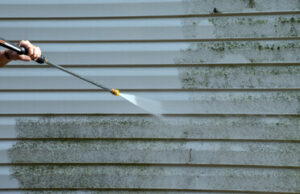How to Perform a Vinyl Siding Repair
Often homeowners have leftover pieces of vinyl siding from when their home was sided and can use these for a vinyl siding repair. If not, many of these repair kits can be purchased inexpensively at most hardware stores. This simple DIY project for small divots and holes can save you money from hiring a professional Charleston Advanced Siding Repair.
 One of the biggest problems homeowners encounter with vinyl siding is cracking. These cracks are typically cosmetic, but can expose your home to bugs and moisture, leading to more serious issues.
One of the biggest problems homeowners encounter with vinyl siding is cracking. These cracks are typically cosmetic, but can expose your home to bugs and moisture, leading to more serious issues.
Cracks in your vinyl siding are usually caused by temperature changes, which cause the material to expand and contract as it adjusts. It can also be caused by damage to the siding, such as from hail or other physical objects that hit the surface. If your vinyl siding is cracked, it is important to repair it as soon as possible.
Depending on the size of the hole, there are a few different methods you can use to patch it. For small holes, you can apply a self-adhesive vinyl patch to the area. Before applying the patch, clean the surface of the vinyl and primer it with Zinsser Bulls Eye 1-2-3 Primer. This will ensure that the patch sticks well and is a good match for your siding color. Then, simply paint over the patch with exterior-grade paint that matches your home’s siding. For larger holes, you can create a backer to go behind the vinyl. This can be a strip of wood or scrap of vinyl that is inserted into the hole, and then glued in place with DAP Dynagrip Heavy Duty MAX Construction Adhesive. You can then attach the patch to this backing, and then secure it with nails or screws. Once the caulk is dry, you can trim, sand, and paint it to match the surrounding surface of your vinyl siding.
Another way to fix small holes in your vinyl siding is to buy a full-length piece of replacement siding. This will provide a seamless repair, but it can be difficult to find a piece that perfectly matches your existing siding color. Most professionals will have special paint mixed that is designed to closely match your existing shade of vinyl.
Over time, your vinyl siding will fade in color due to the sun’s UV rays. This is not necessarily a problem, but it does mean that any repairs made to the vinyl will be noticeable as they won’t match the original shade. You can prevent this from happening by ensuring that your vinyl siding is properly insulated and by planting trees, shrubs, or other items to block the sun’s rays from your house.
Dents
Aside from being unsightly, dents can cause vinyl to pull away from the house frame. This can lead to gaps and water leaks that will quickly deteriorate the vinyl. In some cases, the best option is to replace the damaged panel of siding. To do this, unlock the seams beneath and above the broken piece, and remove the nails or screws holding it in place. If the nails are long, you may need to use a pry bar to separate the piece from the house.
For smaller holes and dents, you can usually use caulk. Start by cleaning the area with soap and water to ensure that the caulk will adhere well. Next, use a putty knife to smooth the surface of the caulk and make sure it is level with your vinyl siding. Finally, allow the caulk to dry completely before touching it again.
If you want to do a more permanent repair, cut a patch from a full-length piece of vinyl siding that matches the color of your home. Alternatively, you can use exterior latex paint to match the patch. When the patch is dry, you can paint over it to hide the patch and keep moisture out of your house.
Another way to fix a hole in vinyl siding is to install a new panel. To do this, unlock the seams below and above the broken piece to free it. Then, use a nail pry bar to take out the nails holding the damaged section in place.
When installing a replacement panel, be sure to align the bottom lip of the new panel with the top lip of the panel above it. You can do this by hand or with a zip tool like the Malco SideSwiper (about $5).
If you have a large hole, you might need to replace more than one panel of vinyl. This is especially important if the damaged section is at or near ground level, where it is more likely to be exposed to moisture. This method will require more tools and take more time than a simple caulking or patching job, but it can be very effective.
Holes
While vinyl is durable and lasts for decades, it’s still vulnerable to damage. It can be scratched by rocks or dents from lawnmowers or Frisbees, or even crack over time. If you notice holes, it’s important to repair them as soon as possible, to keep rain and pests from gaining access to your home.
Luckily, there are some easy ways to fix these small holes and divots. Using caulking, you can easily fill in these areas and make them weather-tight. For larger holes, a vinyl patch can be used to replace the damaged area.
Before applying any vinyl siding patch, be sure to clean the work area and surface of the damaged panel to ensure that it’s properly prepared for adhesion. De-gloss the surface by wiping it down with warm soapy water and a microfiber cloth to remove any dirt, debris, or dust that may interfere with the patch’s ability to adhere. Next, cut a piece of vinyl siding patch that’s slightly larger than the hole from a kit that matches your home’s color and texture. Apply a small bead of waterproof caulk to the back of the patch, and carefully insert it into place. Smooth it with a plastic putty knife and let it dry for two to four hours. Once the caulk is dry, touch up the surrounding area with paint that matches your home’s vinyl siding.
Another way to repair a large hole is to purchase a self-adhesive patch that’s designed specifically for this purpose. These patches are thin and inconspicuous, and can cover a crack or hole that’s the size of a baseball or smaller. They’re available in a variety of colors, so you can find one that closely matches your vinyl. To apply, simply clean the damaged area with alcohol and peel off the backing from the patch. Press the patch into place, then touch up the area with paint to match your vinyl.
If the hole in your vinyl is bigger than a baseball or a little more, it’s probably a good idea to call a professional contractor for an estimate. In addition to allowing rain and pests inside, larger holes can also lead to structural problems that could become more expensive to repair down the line.
Water Damage
When water penetrates a section of vinyl siding, it may cause rot and other problems. This is why it is important to repair water damage quickly. A simple caulking job can prevent further deterioration, as well as prevent insect infestation and mold growth.
In some cases, a damaged panel of vinyl may need to be replaced. Fortunately, this is very easy to do. First, you will need to remove the existing piece from the sheathing, if necessary. This can be done using a pry bar, claw hammer or drill. Afterwards, you will need to expose any nails or screws that hold the broken panel in place. A zip tool works well for this purpose because it will hook underneath the panel and lift it up, exposing any fasteners.
Next, you will need to prepare the replacement siding piece. This can be done by trimming it, if needed, to fit the hole or crack. It can also be sanded down with a utility knife or saw to smooth it and ensure the curves match those of the damaged siding. If you are not using a matching paint, you can also use construction adhesive to bond the new piece of vinyl to the existing siding.
After the adhesive has dried, you will need to apply a bead of caulk around the edges of the repair. The caulk can be painted, if desired, to match the color of the existing vinyl siding.
A small bead of caulk around the edge of the hole or crack will also prevent water from seeping behind the vinyl. When applying the caulk, make sure to clean the surface to ensure optimal adhesion.
If you have a larger area of damage, you can opt to use a vinyl patch kit that is available at most home improvement stores. These kits will usually contain fiberglass cloth and a resin mixture that creates a tough surface that is harder than vinyl. The kit’s instructions should be followed closely to achieve the best results. These kits will require a little more work than a simple caulking job, but they can be much more durable in the long run.
